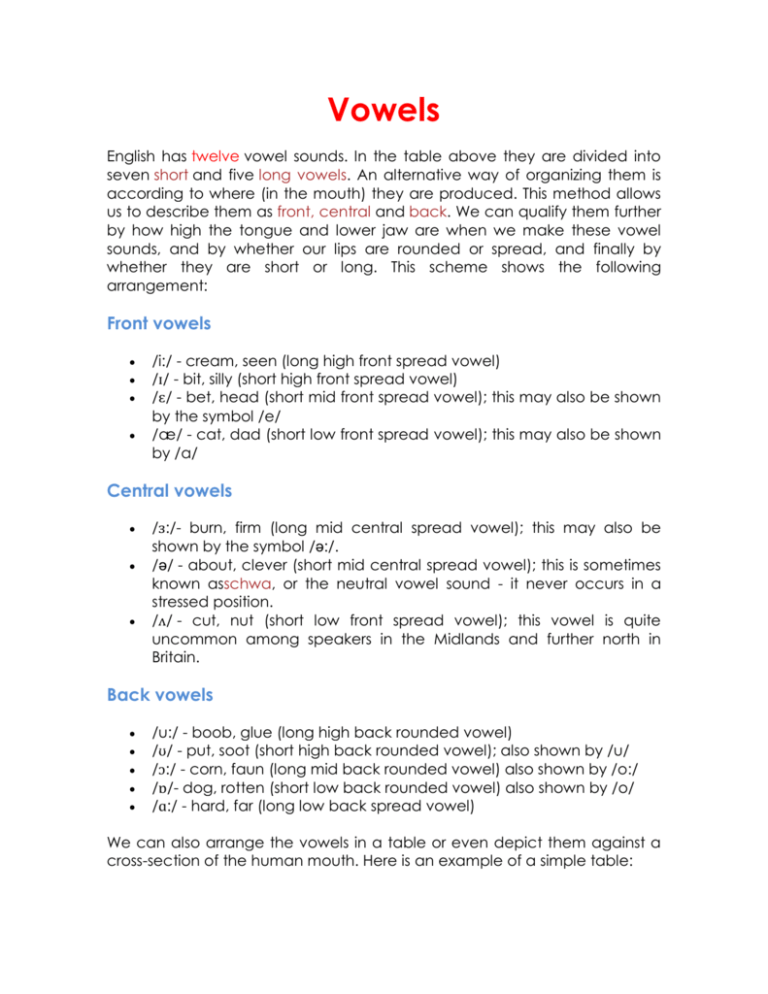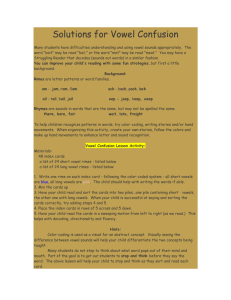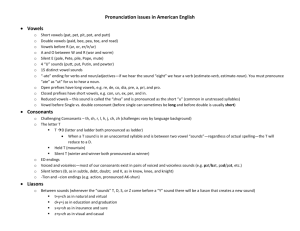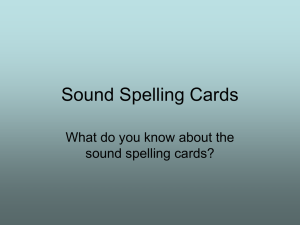Vowels
advertisement

Vowels English has twelve vowel sounds. In the table above they are divided into seven short and five long vowels. An alternative way of organizing them is according to where (in the mouth) they are produced. This method allows us to describe them as front, central and back. We can qualify them further by how high the tongue and lower jaw are when we make these vowel sounds, and by whether our lips are rounded or spread, and finally by whether they are short or long. This scheme shows the following arrangement: Front vowels /i:/ - cream, seen (long high front spread vowel) /ɪ/ - bit, silly (short high front spread vowel) /ɛ/ - bet, head (short mid front spread vowel); this may also be shown by the symbol /e/ /æ/ - cat, dad (short low front spread vowel); this may also be shown by /a/ Central vowels /ɜ:/- burn, firm (long mid central spread vowel); this may also be shown by the symbol /ə:/. /ə/ - about, clever (short mid central spread vowel); this is sometimes known asschwa, or the neutral vowel sound - it never occurs in a stressed position. /ʌ/ - cut, nut (short low front spread vowel); this vowel is quite uncommon among speakers in the Midlands and further north in Britain. Back vowels /u:/ - boob, glue (long high back rounded vowel) /ʊ/ - put, soot (short high back rounded vowel); also shown by /u/ /ɔ:/ - corn, faun (long mid back rounded vowel) also shown by /o:/ /ɒ/- dog, rotten (short low back rounded vowel) also shown by /o/ /ɑ:/ - hard, far (long low back spread vowel) We can also arrange the vowels in a table or even depict them against a cross-section of the human mouth. Here is an example of a simple table: Front High Central i: ɪ Mid ɛ Low Æ Back u: ʊ ə ɜ: ʌ ɔ: ɒ ɑ: Diphthongs Diphthongs are sounds that begin as one vowel and end as another, while gliding between them. For this reason they are sometimes described as glide vowels. How many are there? Almost every modern authority says eight - but they do not all list the same eight (check this for yourself). Simeon Potter, in Our Language (Potter, S, [1950] Chapter VI, Sounds and Spelling, London, Penguin) says there are nine - and lists those I have shown in the table above, all of which I have found in the modern reference works. The one most usually omitted is /ɔə/ as in bored. Many speakers do not use this diphthong, but use the same vowel in poured as in fraud - but it is alive and well in the north of Britain. Potter notes that all English diphthongs are falling - that is the first element is stressed more than the second. Other languages have rising diphthongs, where the second element is stressed, as in Italian “uomo” (man) and “uovo” (egg). The Dipthongs sound oi like in oil and oy like in oy: boy, toy, joy, royal, enjoy, oil, boil, coin, oink, point, noise, voice, soil, join. Sound: au and aw as is sauce and raw because, sauce, August, fraud, taught, cause, laundry, saucer, auction, saw, law, raw, jaw, yawn, lawn, draw, claw, straw, crawl. Sound: ou like in round and ow like in how: cow, bow, now, how, wow, owl, gown, allow, house, mouse, ouch, loud, sound, mouth, out, doubt, round, found. Triphthong. A combination of three vowel sounds in a single syllable, forming a simple or compound sound; also, a union of three vowel characters, representing together a single sound; a trigraph; as, eye, -ieu in adieu, -eau in beau, are examples of triphthongs. The word "triphthong" uses 10 letters: G H H I N O P R T T. Words formed by adding one letter before or after triphthong layer player payee pompeii tyre fire higher liar employer soya sequoia power shower s slower lower noah boa employee dialysis diana biology ionosphere antibiotic Semi-Vowels Semi-vowels are vowel-like sounds produced by a rapid glide on to the next vowel of greater, steadier duration. The English semi-vowels are /j/ and /w/. These sounds are called semi-vowels, semi-consonants and consonants by different authors. They are called consonants or semi-consonants following linguistic criteria established to determine if a sound functions as a consonant, namely: a) Presence of stress: Only vowels receive stress in a syllable; /j/ and /w/ do not (beauty, quite). b) Position in a syllable: A syllable is a sequence of speech sounds consisting of one vowel preceded and/or followed by one or more consecutive consonants. To this some authors add the type of pronunciation given to articles before these sounds in contrast with their pronunciation in pre-vocalic position: /j/ in the uniform, a young man; /w/ in the world, a wide scope. Why then are we calling them semi-vowels? Because, if we look at them from a phonetic point of view, they have no noise component —neither friction nor complete obstruction— and they are basically characterized by the vibration of the vocal cords and the quality given by the resonatory chambers above the larynx. What is essential??? in these sounds is the transitory and instantaneous character of their highest position which distinguishes them neatly from vowels /i/ and /u/. /w/: Voiced, oral, lenis, labio-velar. Description: It is articulated by the tongue assuming the position for a back half-close to close vowel (depending upon the degree of openness of the following sound) and moving away immediately to the position of the following sound; the lips are rounded (more closely when followed by /u/, /U/ or /o/ than when preceding a more open or front vowel). The soft palate is raised and the vocal cords vibrate. In the case of coordinate or double articulation, the two articulations have the same degree of stricture, while in the case of primary and secondary articulations, the secondary articulation is of lower stricture rank than the primary one (i.e. it has a more open degree of stricture). The two articulations are simultaneous and function phonologically as a single segment. Error: Students show a clear tendency to “add a g” before initial or intervocalic /w/, e.g. wait /gweIt/*, only one [‘oUnlIgwÃn]*. They only perceive the velar quality of the sound. Accuracy: For the sake of practice, we may substitute /u/ for /w/ in order to emphasize the latter’s bilabial quality and its low frequencies as compared with those of /g/. For example: Wait. Only one. /j/: Voiced, oral, lenis, palatal. Description: It is articulated by the tongue assuming the position for a front half-close to close vowel (depending on the degree of openness of the following sound) and moving away immediately to the position of the following sound; the lips are generally neutral or spread, but may anticipate the lip-rounding of the following vowel in such cases as you, yawn, etc. Error: In initial position, it is commonly pronounced as Spanish palatal fricative /y/, which is tenser. Accuracy: In order to emphasize laxness in the pronunciation of /j/, we may place it after nasal consonants. We should avoid placing the sound before close, front vowels, which would favor friction. We may also substitute /ɪ/ for /j/. For example: It’s new. Yes. Similarities and differences between diphthongs and semi-vowels. SIMILARITIES: 1. Diphthongs and semi-vowels are gliding sounds. 2. They have a starting point and a point towards which the movement runs. DIFFERENCES Diphthongs: 1. They are treated as vowels. Semi-vowels: 1. They are treated as consonants. 2. They carry the stress. 2. They do not carry the stress. 3. They are central in a 3. They are marginal in a syllable. syllable. 4. In their articulation, the 4. In their articulation, there is a voice delays slightly and there transitory and instantaneous is more stress in the first highest position and a glide element; while the second towards a clear vocalic sound element is very shortly of steady duration. touched. Allophones Allophones are phonetic variations - different pronunciations - of the same phoneme. Using a different allophone does not change meaning. Example The /l/ sound is pronounced differently in ‘love' and in ‘wool'. These two words contain allophones of the phoneme /l/. It is important to be aware of what allophones and phonemes exist in other languages, as these can cause problems when learning the sounds of English. For example, the /b/ and /v/ phonemes in English are only allophones in Spanish and Spanish learners often have difficulty recognizing the difference. Discrimination activities on minimal pairs of words, distinguished only by the phonemes concerned, can help with this. In linguistics, an audibly distinct variant of a phoneme, such as the different pronunciations of the t sound in tar and star. Adjective: allophonic. Substituting one allophone for another allophone of the same phoneme doesn't lead to a different word, just a different pronunciation of the same word. For this reason, allophones are said to be noncontrastive.






